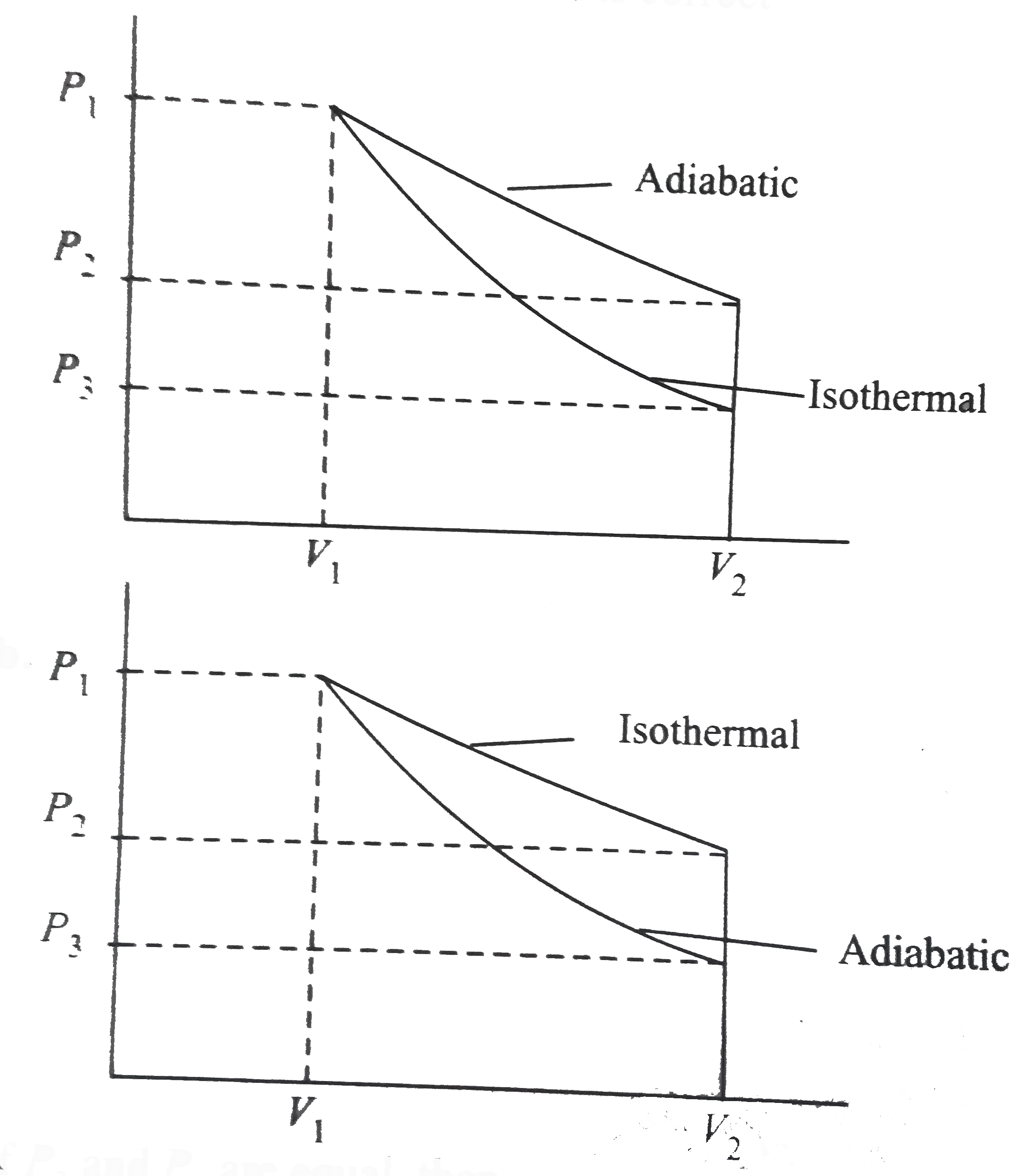A sample of ideal gas undergoes isothermal expansion in a reversible manner from volume to volume . The initial pressure is and the final pressure is . The same sample is then allowed to undergoes reversible expansion under adiabatic conditions from volume . The initial pressure being same but final pressure is .
If and are equal, then
Both
To solve the problem, we need to analyze the two processes: isothermal expansion and adiabatic expansion of an ideal gas.
Step 1: Isothermal Expansion
For an isothermal process, the ideal gas law applies, and we can express the relationship between pressure and volume as follows:
P1V1=P2V2
From this equation, we can derive the expression for V2 during the isothermal expansion:
V2=P1P2V1
Step 2: Adiabatic Expansion
For an adiabatic process, the relationship between pressure and volume is given by:
PVγ=constant
For our case, we can write:
P1Vγ1=P3Vγ2
Rearranging this equation to solve for V2 during the adiabatic expansion gives us:
V2=V1(P1P3)1γ
Step 3: Setting P3=P2
Given that P3=P2, we can substitute P2 for P3 in the adiabatic equation:
V2=V1(P1P2)1γ
Step 4: Comparing V2 from Both Processes
Now we have two expressions for V2:
1. From isothermal expansion:
Visothermal2=P1P2V1
2. From adiabatic expansion:
Vadiabatic2=V1(P1P2)1γ
Step 5: Analyzing the Relationship
To compare these two volumes, we can express the relationship:
Vadiabatic2=V1(P1P2)1γandVisothermal2=P1P2V1
Since γ>1, we know that (P1P2)1γ<P1P2. Therefore, we can conclude:
Vadiabatic2<Visothermal2
Conclusion
Thus, the final relationship we find is:
Vadiabatic2<Visothermal2
For an isothermal process, the ideal gas law applies, and we can express the relationship between pressure and volume as follows:
For an adiabatic process, the relationship between pressure and volume is given by:
Given that P3=P2, we can substitute P2 for P3 in the adiabatic equation:
Now we have two expressions for V2:
Visothermal2=P1P2V1
Vadiabatic2=V1(P1P2)1γ
To compare these two volumes, we can express the relationship:
Thus, the final relationship we find is:
Topper's Solved these Questions
- THERMODYNAMICSBOOK - CENGAGE CHEMISTRY ENGLISHCHAPTER - THERMODYNAMICSEXERCISE - Exercises (Multiple Correct)
50 Videos
- THERMODYNAMICSBOOK - CENGAGE CHEMISTRY ENGLISHCHAPTER - THERMODYNAMICSEXERCISE - Multiple correct Answer Type
2 Videos
- THERMODYNAMICSBOOK - CENGAGE CHEMISTRY ENGLISHCHAPTER - THERMODYNAMICSEXERCISE - Paragraph for Problem
1 Videos
- STOICHIOMETRYBOOK - CENGAGE CHEMISTRY ENGLISHCHAPTER - STOICHIOMETRYEXERCISE - Archives Subjective
33 Videos
Similar Questions
A sample of ideal gas undergoes isothermal expansion in a reversible manner from volume V1 to volume V2. The initial pressure is P1 and the final pressure is P2. The same sample is then allowed to undergoes reversible expansion under adiabatic conditions from volume V1→V2. The initial pressure being same but final pressure is P3.
Which of the following is correct?
View SolutionA sample of ideal gas undergoes isothermal expansion in a reversible manner from volume V1 to volume V2. The initial pressure is P1 and the final pressure is P2. The same sample is then allowed to undergoes reversible expansion under adiabatic conditions from volume V1→V2. The initial pressure being same but final pressure is P2.
Which graphic representation is correct
a.
View SolutionA sample of ideal gas undergoes isothermal expansion in a reversible manner from volume V1 to volume V2. The initial pressure is P1 and the final pressure is P2. The same sample is then allowed to undergoes reversible expansion under adiabatic conditions from volume V1→V2. The initial pressure being same but final pressure is P3.
The work of expansion in adiabatic process (wadi) is related to work of expansion in isothermal process (wiso) is
View SolutionA sample of ideal gas undergoes isothermal expansion in a reversible manner from volume V1 to volume V2. The initial pressure is P1 and the final pressure is P2. The same sample is then allowed to undergoes reversible expansion under adiabatic conditions from volume V1→V2. The initial pressure being same but final pressure is P3.
Which relation is correct (γ=CPCV)?
View SolutionAn ideal gas expands isothermally from volume V1 to V2 and is then compressed to original volume V1 adiabatically. Initialy pressure is P1 and final pressure is P3. The total work done is W. Then
View SolutionAn ideal gas expands isothermally from volume V1 to V2 and is then compressed to original volume V1 adiabatically. Initialy pressure is P1 and final pressure is P3. The total work done is W. Then
View Solution1mol of an ideal gas undergoes reversible isothermal expansion form an initial volume V1 to a final volume 10V1 and does 10kJ of work. The initial pressure was 1×107Pa.
c. Calculate V2.
b. If there were 2mol of gas, what must its temperature have been?
View Solution1mol of an ideal gas undergoes reversible isothermal expansion form an initial volume V1 to a final volume 10V1 and does 10kJ of work. The initial pressure was 1×107Pa.
a. Calculate V2.
b. If there were 2mol of gas, what must its temperature have been?
View SolutionA sample of gas expands from volume V1 to V2. The amount of work done by the gas is greatest when the expansion is
View SolutionA monatomic gas at a pressure P, having a volume V expands isothermally to a volume 2 V and then adiabatically to a volume 16 V. The final pressure of the gas is ( take γ=53)
View Solution
